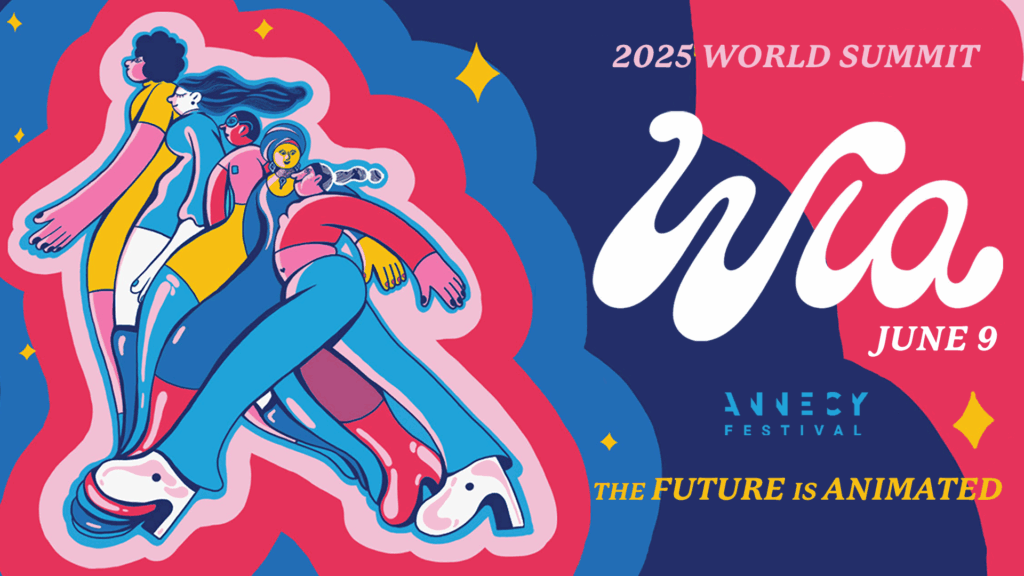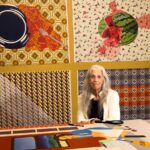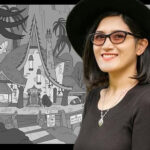

WIA World Summit Artist – Luca Tóth
Meet Hungarian animation director and illustrator, Luca Tóth, chosen to create this year’s WIA World Summit artwork. As the Annecy International Animation Film Festival – host of this year’s Summit – spotlights Hungary as its featured country, Tóth’s selection carries special significance. Born in 1989, the artist honed her craft at Budapest’s Moholy-Nagy University of Art and Design before earning her Master’s at London’s Royal College of Art, with her graduation film The Age of Curious winning Annecy’s Jury Distinction Prize – foreshadowing this full-circle moment in her career.
Tóth’s bold work showcases Hungary’s vibrant animation scene. Her independent shorts Superbia (2016) and Mr. Mare (2019) premiered at Cannes’ Critics’ Week and Berlinale, respectively, collectively screening at more than 150 festivals worldwide.
For this year’s WIA World Summit, Tóth’s piece channels her signature exploration of movement and human connection. The artwork promises to reflect both her nation’s rich artistic heritage and WIA’s mission, creating a visual bridge between animation’s past and its inclusive future. Learn more about Tóth, her process and why she feels supporting new artists is important.
Think back to the earliest moment in your life when you realized you loved creating art and please share it with us.
I don’t really have a first memory of loving art or enjoying craft. It’s really something that was always with me. I remember one time when I was in kindergarten, I became fascinated by the idea of drawing a character or a face or a whole body with just one line. So that was fun. I’ve always liked drawing.
Did your family encourage you in your pursuit of art as a career? If so, how? If not, how did you move forward in your pursuit?
I have family that has a love of art. I have a lot of artists I have grown up with. In fact, we have painters and textile artists and photographers. My mom is an art historian, so art was in my way of growing up for sure. So in one way, it was really easy because they didn’t assume that being an artist is some sort of non-useful or non-important thing. On the other hand, there can be fights and different types of hardships when your whole family’s in the sort of career that you want to approach. It was hard to step into it in some ways. And it was, I think, much easier than for others in other ways.
What, if any, adversities have you faced in your career or life in general, and how did they shape the artist you are today?
I have faced many adversities, of course, and hardships, just like any other human. I feel like all those things that are hard in my life or for me as a person, those inner conflicts, have really boiled for a really long time inside me. So I guess it’s always the question of how you can turn your hard times into something flourishing.
How do you keep your artistic spirit refreshed, even when under the pressure of production deadlines or life challenges?
On one hand, I like to do stuff that I am not necessarily comfortable with. So, for example, I like to take on new sorts of growth, like painting or creating huge rugs, or wall art table blocks. And I find it very inspiring when you learn something new and you feel like a child. You feel this sort of urgency to prove yourself, but at the same time very aware that you are not really the master of that craft. That is the sort of thing that keeps me alive, keeps me flourishing. I really like deadlines, and I think a little bit of stress can help you sometimes. It depends on your personality, of course, but sometimes, it’s harder to do a project that’s prolonged, and you never have a deadline. I like this sort of guidance.
Why is an organization like WIA important?
Advocacy work is really important in any field. In the last 17 years, I’ve been in this industry, a lot has changed, and I think we still have places to improve. Of course. In general, I think mentorship programs and helping out people who are new to this industry are key to further involvement. And WIA is an organization that does that.
How did this assignment for WIA at the World Summit in Annecy come to you, and how has it evolved?
This year, Hungarian artists’ work is going to be honored at the Annecy festival. And I think WIA wanted the Hungarian artists to create this piece for them, and they picked me. I’m very happy about it.
What message do you hope to convey through this art?
In my usual art pieces, I like drawing women in groups and portraying the sort of attachment that comes with that. I gain a lot from my female friendships, and it’s meaningful to me on a bigger scale. In this case, I wanted to draw something that has a sort of animation gesture to it. So all these characters are in the same line of movement—they are in different frames of the same step. They move together just in that line.
What advice do you have for young people looking at animation or other artistic industries as their career field?
I usually don’t like giving black and white advice for people starting in this industry. Everybody needs to find their own path. What I do advise is this: If you’re studying animation – whether just starting or already in school – it’s important to realize how many different directions you might want to prove yourself. Some people want to make rebellious short films, others want to create for video games, or music videos, or commercial work. And then there’s wanting to prove yourself to parents, grandparents, and friends. These different pulls can really stretch you thin, especially in stressful times like graduation. So I tell them: Make a list of everyone you want to impress. You don’t have to work on that list, but just knowing who’s on it helps. When you see those names written down, it lets you focus a bit more on yourself.


WIA AWARDS 55 EMERGING CREATIVES WITH 2024-2025 WIA SCHOLARSHIPS

Cristina Zuniga: WIA Stories of Impact


